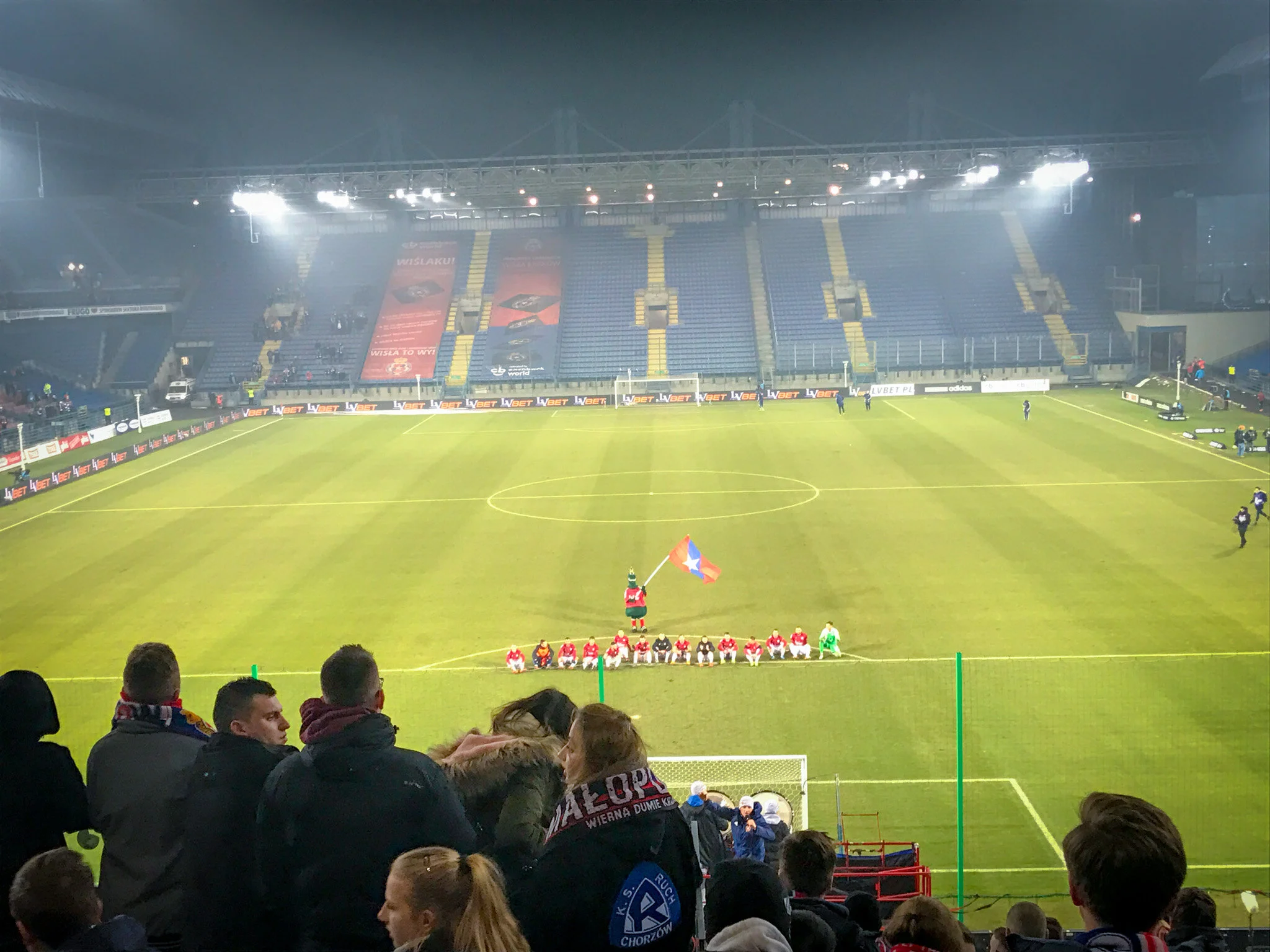Stadium Guide: Stadion Miejski im. Henryka Reymana, Wisla Krakow
/Stadion Miejski im. Henryka Reymana, Wisla Krakow
Opened: 1953 | Tenant(s): Wisła Kraków | Capacity: 33,268
History
Me outside the home of Wisla Krakow on my first visit to Poland in January 2015.
Stadion Miejski im. Henryka Reymana was built in 1953 on a plot of land next to Wisla’s old stadium, and is the team’s third home. Their first stadium burned down and the second, despite avoiding destruction in World War II, couldn’t cope with the post-war popularity of football.
Originally, Stadion Miejski im. Henryka Reymana was named Stadion Wisly, and was oval-shaped with a running track around the pitch. Floodlight masts were installed in 1972, and four years later the venue received its record attendance of 45,000 for a UEFA Cup game against Celtic.
In 1985 Wisla presented a redevelopment plan and demolished the main stand, but after running into financial troubles they were left without a stand in its place for over a decade. The main stand was finally constructed in 1996 and in the following years the ground underwent a major renovation, including the removal of the running track and the installation of temporary stands, to make it into a dedicated footballing venue.
A new renovation project was unveiled in 2004, which had the goal of creating a stadium with a capacity exceeding 20,000 seats, with the main stand, constructed in the ‘90s, remaining. In 2007 it was announced that Poland would be a co-host for Euro 2012 and that Stadion Miejski im. Henryka Reymana was to be a backup stadium, so plans were altered to meet the UEFA requirements for elite class stadiums.
Due to ongoing construction works, Wisla Krakow played their 2009/10 home matches at smaller venues in nearby Sosnowiec and Krakow, and the first game back at Stadion Miejski with all four new stands took place in October 2011, in which Wisla won 3-1 against Jagiellonia Bialystok.
Stadion Miejski and Marshal Józef Piłsudski Stadium (above) are only separated by Błonia Park. You’ll msot likely pass Cracovia’s Stadium if you’re travelling to Stadiuon Miejski from the city centre.
In 2008 Stadion Wisly was renamed Stadion Miejski im. Henryka Reymana after legendary goalscorer and captain Henryk Reyman, who represented the club from 1910 to 1933, won 12 caps for the Polish national team and captained Poland at the 1924 Olympic Games in Paris.
Who are Wisla Krakow?
Ultra stickers inside Stadion Miejski.
Wisla Krakow are one of Poland’s most successful teams. Founded is 1906 under the name TS Wisla, they have won the Polish league 14 times, although only having 13 titles to their name as in 1951 the Polish Champion mantle was awarded to Polish Cup winners Ruch Chorzow, in addition to four Polish Cups.
The club formed when students of the Second Practical School in Krakow decided to set up a football club, but it wouldn’t be until 21 years later that the first-ever Polish football championship took place. Wisla became the inaugural Polish football champions behind Henryk Reyman’s 37 goals, adding to their victory in the first Polish Cup tournament the year before, although that would not be contested again until 1951.
They retained the league in 1928, but would go trophyless until their next triumph in 1949, the same year that their name changed to Gwardia-Wisla Krakow, then changing again to TS Wisla and GTS Wisla before the club was bought by TELE-FONIKA Kable S.A. in 1998 and renamed Wisla Krakow SSA.
Since the takeover, Wisla have reaffirmed their position amongst the Polish elite, adding eight Ekstraklasa championships and two Polish cups to their roll of honour.
Although they have qualified for Europe on a number of occasions, Wisla have generally performed poorly, with their most notable performance coming in the 1978-79.
The club has two major rivalries. One is with Legia Warsaw, due to their success and the rivalry between Poland’s two premier cities of Krakow in the south and Warsaw in the north. The other is the local derby, dubbed the ‘Holy War,’ with KS Cracovia, and the two teams are separated only by a thin stretch of Błonia Park.
Getting to Krakow
Krakow John Paul II International Airport is named after Pope John Paul II, who was born just 50 kilometres away from the Polish city in Wadowice.
Major budget airlines easyJet and Ryanair fly to Krakow Airport from various locations around the United Kingdom and Europe.
Krakow is also served well by trains and buses which arrive from all over Poland and Europe throughout the week, with most terminating at Krakow Główny, the city’s central interchange.
From the airport, there are regular trains and buses opearate from arrivals to Krakow Główny, which cost less than £1 for two people. Taxis are freely available, but usually cost a considerable amount more.
Getting to Stadion Miejski im. Henryka Reymana
One of Krakow’s blue trams.
Stadion Miejski im. Henryka Reymana is roughly a 20 minute walk from Main Market Square. Trams 15 and 18 also run from the centre to the stop Reymana, which drops passengers off right outside the ground. Buses 103, 139, 144, 159, 173 and 194 all stop at Kawiory, which is just a short walk down ulica Miechowska to the stadium.
My hotel was approximately a 45-minute walk from the venue and I got Uber taxis there and back, which cost me approximately 10 Polish Zloty, or £2, each way. It’s door-to-door and super cheap.
Tours and merchandise
My Wisla Krakow shirt and scarf.
Official club merchandise is available at the club’s store right outside the stadium and is open daily, as well as a number of kiosks inside the ground on matchdays. Wisla Krakow also have an online store that ships worldwide. Currently the club aren’t offering any tours of their Stadion Miejski facility.
Matchday experience
Wisla Krakow players celebrate with fans after a thrilling 3-2 victory over Arka Gydinia in February 2018.
Wisla Krakow generally don’t tend to sell out games, although have larger crowds for high-profile games, such as the visits of Cracovia and Legia Warsaw. Despite that, the atmosphere can be lively, particularly for those sat in the North Stand where Wisla’s hardcore fans are located. They tend to stand for the entirety of the game, chanting continuously, waving scarves and being led by a man with a megaphone and another banging on a drum.
But if you’re there just to watch a game of football, it might be best to sit in the East or West stands, away from both the ultras in the north and away fans in the south.
Food and drink is readily available inside the stadium on a matchday.
Much like the ticket prices, food and drink at the stadium is inexpensive, and alcohol can be bought at kiosks and consumed in the stands. A great variety of food vendors can be found outside the stadium, with cuisines from countries including Mexico and Italy on offer.
Wisla Krakow merchandise is also available from the concourses in the stadium, as well as in the club shop before and after games.
Tickets
Do'n’t forget to show your ticket as you enter the gate at Stadion Miejski!
Tickets are available at the stadium’s ticket office which is open throughout the week and on the day of the game. Although Wisla games rarely get near full capacity, it is best to purchase your ticket in advance as queues on game day can be quite long with people both buying and collecting.
Foreigners do not need a fan card or a PESEL number and photograph in order to make a purchase, but make sure you take your passport or driving licence with you as photograph ID is needed to obtain Wisla Krakow tickets. Prices are low and affordable, and discounts are offered for children, senior citizens and students, on presentation of a valid student card.
Safety
Wisla’s hardcore fans typically stand throughout the game.
Attending football matches in Poland is generally safe and not as dangerous as it used to be, but make sure to take normal precautions, such as not getting too drunk before entering the stadium or antagonising opposition fans.
People and bags are searched before entering the stadium, and while cameras of a DSLR grade are allowed inside, telephoto lenses and professional video cameras are prohibited. Click for a full list of Wisla Krakow’s stadium regulations.



























Here's the information you need to know if you plan on watching Wisla Krakow at Stadion Miejski.